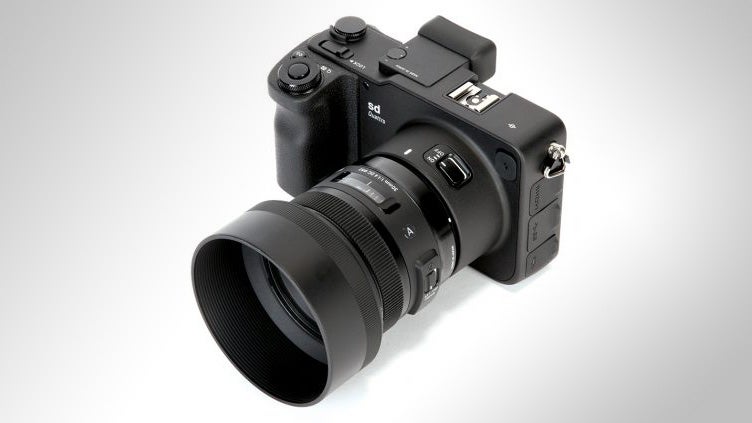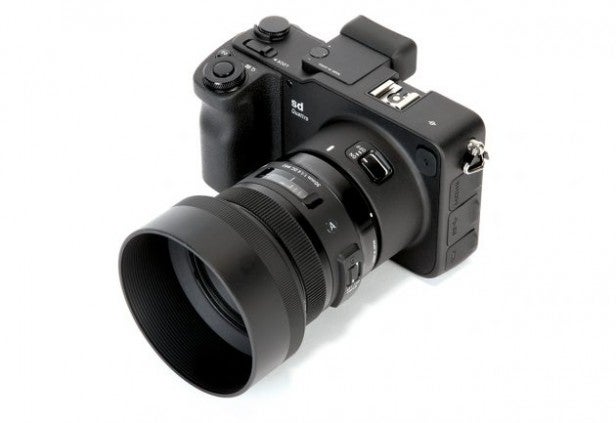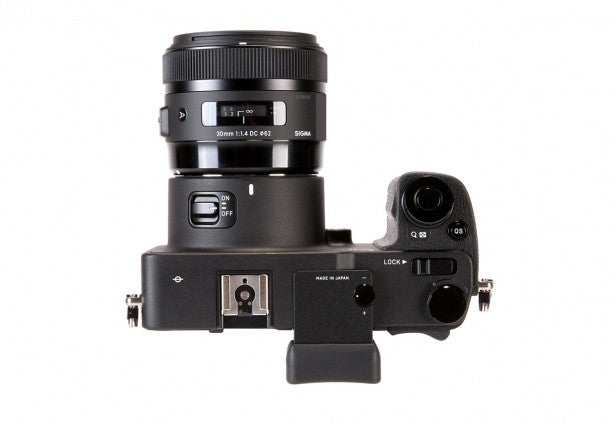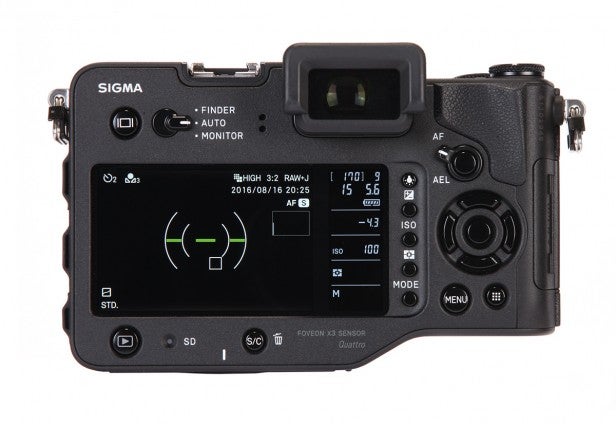Sigma sd Quattro Review
Sigma sd Quattro
An unconventional mirrorless camera

Sections
- Page 1 Sigma sd Quattro Review
- Page 2 Autofocus and Performance Review
- Page 3 Super Fine Detail Mode and Verdict Review
Verdict
Pros
- Excellent image quality at low ISO
- Clear and easy-to-use interface
- Good level of customisability
Cons
- Poor high ISO performance
- Slow autofocus
- No video capture
Key Specifications
- Review Price: £799.00
- Foveon X3 Quattro APS-C sensor
- ISO 100-6,400
- 2.36-million-dot EVF
What is the Sigma sd Quattro?
Sigma is best known as a leading third-party lens producer, but it also has a long history of selling cameras. Having made a couple of 35mm SLRs with its proprietary all-electronic SA lens mount, its first DSLR appeared in 2002, based around the unique triple-layer Foveon X3 sensor.
Its current dp Quattro fixed-lens compacts have a clear, if somewhat niche, appeal, with exceptional lenses and superb image quality at low ISOs. The camera we’re considering here, the sd Quattro, uses the same sensor, but with interchangeable lenses. It’s one of a pair of externally identical cameras, with the sd Quattro-H having a larger, higher-resolution 25.5-megapixel sensor with a 1.3x crop.
Related: Best cameras
With the new model, it appears that Sigma has learned some difficult lessons from its experience with the ill-fated SD1 DSLR of 2010, which was underpowered and overpriced. First, with a body-only price of £799, the new sd Quattro is much more reasonably priced. Second, while it’s based around the same SA mount, the model is not an SLR at all, but a mirrorless camera with an electronic viewfinder.
Sigma sd Quattro – Features

The sd Quattro’s most important feature is its Foveon X3 Quattro image sensor. Unlike conventional sensors, which use a pattern of red, green and blue filters over their light-sensitive photodiodes to determine colour, it’s based around the fact that the different colours of light can penetrate silicon to different depths. It has a top layer with 19.6 million pixels that’s most sensitive to blue light, with two layers beneath that each use 4.9 million pixels four times larger in area, and that are sensitive to green and red light. Because of this arrangement, Sigma calls it a 29.5-million-pixel sensor.
This unique approach means that its X3F RAW files can only be processed using Sigma Photo Pro (SPP). Unfortunately, this is one of the slowest and least intuitive pieces of software I’ve ever used, and it’s a serious weakness of the entire system. It’s capable of delivering good results, but you’ll need a fast, up-to-date computer and the patience of a saint.
On paper, the sd Quattro looks like a reasonably well-equipped camera. Its output resolution is 19.6 million pixels, although the unusual design of the Foveon sensor promises to capture finer detail and colour gradation compared to a conventional Bayer sensor with a similar pixel count. The sensitivity range covers a decidedly modest ISO 100-6,400, and files can be captured in the 14-bit losslessly compressed X3F RAW format. These can now be converted to JPEGs in-camera after shooting, with plenty of control over processing parameters such as brightness and white balance.
Shutter speeds range from 1/4000 sec to 30 sec, with a bulb option and 1/180 sec flash sync speed. Continuous shooting is available at 3.6fps with a 12-frame RAW buffer, and files are recorded to a single SD card. In keeping with the camera’s market positioning, only the four key exposure modes – program, aperture priority, shutter priority and manual – are on offer.

As is usual for mirrorless cameras, both autofocus and metering employ the main imaging sensor. According to Sigma, AF uses a hybrid system with both phase detection and contrast detection on board; users can either select from a nine-point mode, or move the focus area freely across a space roughly 75% of the height and width of the frame. The focus area can also be changed in size in three steps, including a fine point for focusing on a precise part of the scene. Face detection is also available.
One unusual addition is Sigma’s new SFD mode, standing for ‘super fine detail’. While this superficially resembles the high-resolution modes found in recent Pentax and Olympus models by shooting a series of exposures and combining them into a single RAW file, here it brackets seven shots at one-stop increments. In essence, this makes it a high dynamic range mode, designed to record extra detail in the shadows and highlights for post-processing.
Other features are notable by their absence. There’s no built-in flash: you can use either a hotshoe-mounted unit or employ the PC sync port on the front plate. Unusually for a modern camera, the sd Quattro has no video mode, and Wi-Fi connectivity is missing too, although support for Eye-Fi cards is included.
Sigma sd Quattro – Build and Handling
When you first pick up the sd Quattro, it’s clear that this is the least conventionally designed interchangeable-lens camera around. It’s as large as an enthusiast DSLR, such as the Nikon D7200, but rather oddly shaped, with a flat top-plate but scalloped base and a viewfinder that’s unusually offset towards the right-hand side.
There’s little to complain about in terms of build quality, with the dust- and splash-proofed magnesium-alloy body feeling solid in your hands, helped by the chunky grip. The twin electronic control dials rotate with satisfying detents, with sufficient resistance that they won’t get accidentally knocked, but without being too stiff. All the switches click positively into place, and the buttons that festoon the body have a deep travel with positive end points.
Sigma’s interface is very clear and logical, with sensibly laid-out menus and attractive viewfinder displays that are informative without being overwhelming. There’s a decent amount of customisation on offer too: you can define exactly how the control dials work in each exposure mode, and configure the on-screen QS menu to give speedy access to your most-changed functions.

However, it’s the positioning of the buttons and switches that’s often perplexing. The power switch is placed awkwardly on top of the protruding lens mount, and there’s a second sliding lock switch behind the shutter button that, by default, disables almost all the control buttons but not the shutter button or dials. I set it to send the camera to sleep mode and conserve battery, which makes more sense to me, but I’d rather see a single easily accessible power switch.
The D-pad on the back of the body is large and positive, and perfectly placed for moving the focus point around the frame while you’re shooting. But unlike most cameras you can’t do this directly; instead, you first have to press a small button towards the bottom of the camera body that requires considerable movement of your thumb to locate. As the D-pad buttons have no other direct function, this seems like an unnecessarily awkward extra step.
The ISO button is also poorly placed in the middle of a column of five identical tiny buttons beside the screen, so is difficult to identify by touch alone. On other cameras this would be a serious criticism, but less so on the sd Quattro, as its poor high-ISO performance means you probably want to keep the camera set to ISO 100 as much as possible, anyway.
After spending a bit of time using the sd Quattro and tweaking its setup, I found it to be a perfectly usable camera. But I can’t help thinking that Sigma’s unconventional design pays few real dividends. The reality is that DSLRs and DSLR-shaped mirrorless models are popular for a reason – their shape and layout help make them very quick to use.
Sigma sd Quattro – Viewfinder and Screen

Specs-wise, the sd Quattro has a bang up-to-date viewfinder and screen. Its EVF uses a 2.36-million-dot panel and offers a magnification equivalent to 0.73x. The 3-inch rear screen has a 1.62-million-dot resolution, although it’s fixed rather than articulated, and isn’t touch-sensitive. One nice feature is the addition of a small OLED sub-monitor alongside the LCD that displays key settings such as shutter speed, aperture, metering mode, ISO and exposure mode.
In practice, both the viewfinder and screen are bright, clear and sharp. But they’re badly let down by a low-resolution live-view feed, which appears pixelated and over-sharpened. This is particularly obvious when using the EVF, and is a shame because the rest of the on-screen interface is so good.
One nice touch is a large switch beside the eyepiece that allows you to select between viewing with the EVF or LCD or changing between the two automatically using an eye sensor. It’s much more intuitive and satisfactory than having to cycle between modes by pressing a button, and I wish more camera makers would follow suit. When using the EVF, the rear screen can be set to display the camera’s detailed status, or turned off completely to conserve power.
Related: Best action cameras
I mostly preferred to use the electronic viewfinder, reverting to the rear screen for tripod work. The EVF’s position to the right of the camera does feel odd, but it works OK when you get used to it. The large eyecup does a great job of blocking glare, and because it protrudes so far from the back of the camera, there’s no problem accessing any of the buttons with the camera to your eye.
The sd Quattro will preview your exposure, white balance and colour mode, giving a good idea of how the image should turn out before you press the shutter button. Lots of useful extras can be overlaid on the live-view display, including gridlines, a dual-axis electronic level display and a live histogram. Indeed, users can configure up to four custom views each for the EVF and LCD, and cycle through them using the display button.
Mystifyingly, I could find no way of engaging depth-of-field preview; instead, the camera always views with the lens set wide open. This is one area where mirrorless cameras should have significant advantages over DSLRs, as their electronic viewfinders can show accurate depth of field at large apertures and don’t necessarily go dark at small apertures.

